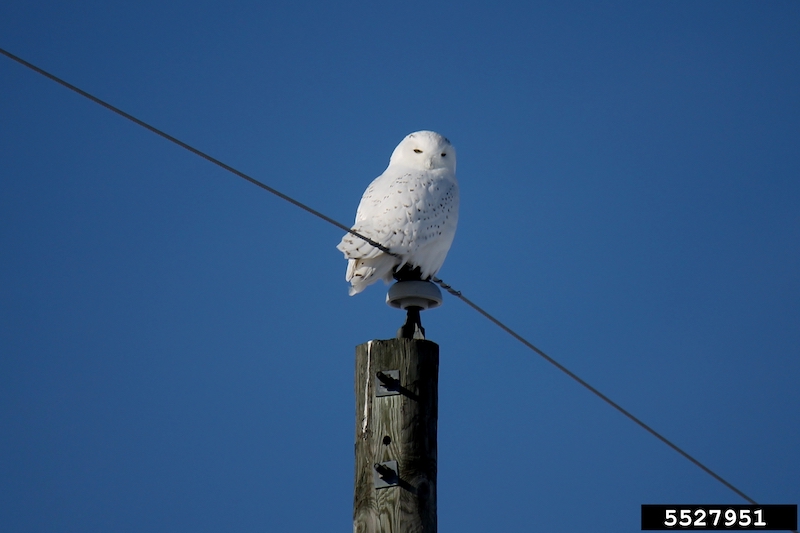Photo by U. S. Fish and Wildlife Service.


Snowy Owl Winter Visitor to Illinois

Each year as winter approaches, nature enthusiasts wonder when a snowy owl or two will venture into Illinois, and whether it will be an irruptive year, meaning many more will descend on the Prairie State for the season.
Identifying a Snowy Owl

To see a snowy owl in Illinois is to glimpse a piece of the northern wilderness. Male snowy owls are nearly pure white, producing more white feathers as they age, with a black bill and yellow eyes. Snowy owls lack ear tufts. Their legs are feathered to the tips of their toes. Females have brownish barring on their white feathers, and young birds have many dense black hairs and mottling. Standing 2 feet tall and having a 4-foot wingspan, the snowy owl raises its young on the remote Arctic tundra at a time when the sun shines nearly 24 hours a day.
Life on the Tundra
Behaviors such as courtship can only be witnessed on the tundra, not in Illinois. The male snowy owl courts a female by lifting into the air, then flying with wide wingbeats while holding a lemming in his bill or talons. He returns to the ground and drops his prey, fanning his tail to get a female to notice him.
The female uses her body to shape a depression into the bare ground where she will lay 3 to 11 eggs. It takes 32 days for the eggs to hatch and then up to another 25 days before the young can leave the nest. The number of eggs she lays often depends on how much food is available on her nesting territory.
During the breeding season, snowy owls feed lemmings, voles and other rodents to their young. They may also feast on birds called ptarmigan as well as rabbits.
Moving South in Winter
In autumn, some snowy owls move southward into the northern United States, including as far south as Illinois. Some years, one or two will be found in Illinois, most likely in the northern part of the state. But, in other years, more individuals of the owl with piercing yellow eyes will descend southward in what’s termed an irruption, or a population boom that results from an increase in prey species. These cycles may occur once every 4 to 5 years and result in a number of snowy owls moving southward. For example, during the winter of 2011/2012 “double-digit numbers of owls were observed along Chicago’s lakefront,” wrote Jeff Smith in “How to have a Gr-eight Owling Day,” in Meadowlark: Journal for Illinois Birds, published in 2014.

The owls that season also were found “well inland, even extending to the far reaches of southern Illinois,” he wrote. Typically, the owls don’t go much farther south than central Illinois in winter, according to the College of Veterinary Medicine Wildlife Medical Clinic at the University of Illinois in Champaign. The clinic has cared for snowy owls found injured from automobile collisions and other reasons during winter in the region.
Studies by avian consultant and author Paul Kerlinger show that most of the owls found outside their breeding range in winter are immature birds. They aren’t mostly all white like adult males but have extensive black markings on their bodies.
Where and When to See Snowy Owls
Though scientists have linked the southerly movement of snowy owls to food availability, the birds likely are not starving, according to Project SNOWstorm. Founded in 2013, Project SNOWstorm focuses on collaborative research projects on the snowy owl. Banding studies have shown the nomadic owls in southerly locations in winter are, for the most part, finding plenty to eat, according to Project SNOWstorm.
In the Chicago region, snowy owls can catch plenty of rats, pigeons and ducks along the lakefront, where they are often found in winter. Birders have seen snowy owls along Lake Michigan, just south of the Wisconsin border, eating American coots.
In winter in Illinois, snowy owls roost and hunt along the open edges of and on ice-covered lakes, such as Lake Michigan. They also rest and hunt in agricultural fields as well as fields in airports. These places mimic the wide, open, treeless tundra region where they breed.
A snowy owl also may be found perched atop signs, chimneys and buildings in towns, and open rural areas on haystacks and fence posts, and along railroad tracks.

Snowy owls are active during daylight hours, which improves the chances of seeing one. Longtime birder and birding blog author Robert Hughes reported that a snowy owl appeared on March 25, 2022, on the fishing pier near Montrose Harbor. He had seen one there 10 days earlier. It’s a favorite roosting place for the snowy owl that ventures to Illinois in winter, he said.
Scientists say snowy owl numbers are declining. Partners in Flight has placed the snowy owl on its yellow watch list after estimating a global breeding population of about 29,000 of this species, much fewer than an earlier estimation of roughly 300,000. In December 2017, the International Union for Conservation of Nature listed the snowy owl as vulnerable.
Scientists and birders say that’s all the more reason for being extra careful when searching for snowy owls in winter. Trying to attract the owl for a better photograph could lead to its demise, especially in an area inundated by traffic. The best way to look for snowy owls in winter in Illinois is to join a trip lead by experts who know where to find them and how best to approach them.
Sheryl DeVore writes environment and nature pieces for regional and national publications and has had several books published, including “Birds of Illinois” co-authored with her husband, Steven D. Bailey.
Submit a question for the author
Question: I saw a snowy owl in Metropolis, the most southern city in Illinois, about 5 or 6 years ago. It was chasing a squirrel, which got away running along a telephone wire. It then stayed perched atop the pole. I got a picture, but it’s from a very cheap camera phone. That must of upset it, because all of the sudden, while trying to get more photos, it started dropping shrubbery on me! I think it was perturbed not to catch its prey!
Question: I had an encounter with a snowy owl in Decatur, IL in September of 2020. One of the most memorable wildlife encounters of my life. As I have learned now a few years later how unusual this encounter was, I was curious as to the importance of this event as far as to the understanding of the movement and migration of this rarely seen bird. Is there someone I should report this to? I know it’s been a few years but the exact time and place would be easily known as it was during a traffic stop that the full grown male (all white and nearly 3ft tall) flew in and landed within a few feet of me. I mean directly in front of me as I was leaning against the back of my car waiting for my speeding ticket. Truly a magical experience dispite the ticket that was being written as it happened. Even more wonderous as it was in the middle of the city in an alley 11 pm two police suvs with lights going.
Subscribe to our Newsletter
Explore Our Family of Websites
Similar Reads
The 2025-2026 Upland Hunting Forecast
November 3, 2025 by Don Kahl
Remembering John L. Roseberry
November 3, 2025 by John Cole
Nature’s Seasonal Events
November 3, 2025 by Carla Rich Montez
Everyone Poops: The role of Canada geese in transporting bacterial communities
November 3, 2025 by Auriel M. V. Fournier
The Pileated Woodpecker: An iconic bottomland forest inhabitant
August 1, 2025 by Kathy Andrews Wright
A Captivating Sight – Caspian Terns Swooping Over Chicago
August 1, 2025 by Michael Kamp
Putting Piping Plovers Back on the Map
August 1, 2025 by Laura Kammin
A Nature Walk by the Chicago River
August 1, 2025 by Sima Shah
Imani and Searocket: A Story of Sand and Storms
May 1, 2025 by Brad Semel, Laura Kammin
Let’s Make This Perfectly Clear
May 1, 2025 by Patty Gillespie